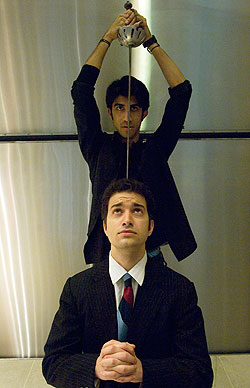For many actors, Hamlet is the Mount Everest of roles: a four-hour, 3,000-line trek to be approached only at the height of one’s professional powers. As a result, many productions feature leads — from Sir Laurence Olivier and Sir John Gielgud to Mel Gibson and Kenneth Branagh — who are well into middle age.
Yet that is a fundamental misreading of the text, argues Henry I. Schvey, Ph.D., professor of drama in Arts & Sciences.

“Hamlet is as much a story of adolescence as Romeo and Juliet,” Schvey said. “Remember, Hamlet is at university when he is suddenly called back to attend his father’s funeral, and there are numerous textual references to his youth. Indeed, many of the characters — Horatio, Laertes, Rosencrantz and Guildenstern — are university students, and Ophelia is younger still,” Schvey said.
Beginning Feb. 13, Schvey — who founded the PAD’s Shakespeare Summer Globe Program in 1989 and who has served on The Shakespeare’s Globe Centre USA Advisory Committee — will direct a new production of “Hamlet” in the A.E. Hotchner Studio Theatre.
Performances begin at 8 p.m. Feb. 13 and 14; and at 2 p.m. Feb. 15. The production continues the following weekend at 8 p.m. Feb. 20 and 21; and at 2 p.m. Feb. 22.
Set in the present day and using modern dress, the production is designed to showcase the prince of Denmark as “a very young man, trapped in a politically dangerous world that, despite his remarkable and profound intelligence, he is ill-equipped to handle,” Schvey said.
The tradition of Hamlet being played by older actors may date back to Richard Burbage (1567-1619), Schvey said. The star of Shakespeare’s own company, the Lord Chamberlain’s Men, Burbage would have been in his mid-30s when the play was written and first performed.
“It is certainly a daunting role,” Schvey said. “It’s the longest play in Shakespeare, and Hamlet is onstage for all but about 20 minutes.
“But the essence of the story is youth. Much has been made about the mystery of the character — his impulsivity, his erratic behavior and swings of emotion. And, yet, if we see Hamlet as a teenager rather than as a middle-aged man, things that seemed incoherent suddenly ring true,” Schvey said.
Take the strained relationship between Hamlet and his widowed mother, Queen Gertrude. As the play begins, Gertrude has rather hastily remarried her brother-in-law, Claudius — a decision that profoundly upsets her son and helps set the tragedy in motion. Yet no less a critic than T.S. Eliot called Hamlet “an artistic failure” on the grounds that it does not adequately explain the depth of Hamlet’s revulsion.
“Hamlet is up against the difficulty that his disgust is occasioned by his mother,” Eliot wrote, “but that his mother is not an adequate equivalent for it; his disgust envelops and exceeds her.”
Yet Schvey said that what caused such insurmountable problems for Eliot makes perfect sense when Hamlet is cast as a teenager.
“What the play illustrates, with remarkable psychological insight, is a young man’s repulsion for a parent who has suddenly and unexpectedly displayed overt sexuality,” Schvey said.
This emotional dynamic underscores another of the play’s central mysteries: Hamlet’s treatment of his own beloved, the young noblewoman Ophelia.
“Hamlet not only feels betrayed by his mother, but he also jumps to the conclusion that all women are similarly duplicitous,” Schvey said. “It’s a leap that may seem extreme for an adult but is entirely plausible for the mind of the adolescent.”
The cast of 27 is led by senior Sathya Sridharan as Hamlet, senior Justin Joseph as Claudius and junior Virginia Page as Gertrude.
Also starring is sophomore Julia Mellon as Ophelia, junior Iain Prendergast as Polonius, sophomore Dan Tobin as Laertes and senior David Weiss as Horatio. Sophomores Jonathan Levinson and Eli Keehn play Rosencrantz and Guildenstern.
The sleek, contemporary set design — which subtly mimics the look and flow of an Elizabethan stage — is by Angela Bengford, lecturer in the PAD. Costume design is by senior Catherine Elhoffer.
Lighting is Sean Savoie, lecturer in the PAD. Sound is by senior Kevin Liu.
Tickets — $10 for students, senior citizens, faculty and staff and $15 for the public — are available through the Edison Theatre Box Office and all MetroTix outlets.
For more information, call 935-6543.
Additional events enhance ‘Hamlet’ experience
In conjunction with “Hamlet,” the Performing Arts Department (PAD) in Arts & Sciences will host a symposium on “Hamlet and the Adolescent Mind” at 10 a.m. Feb. 21 in the Ann W. Olin Women’s Building Formal Lounge.
Co-sponsored by the Center for the Study of Ethics and Human Values and by the Department of Psychology in Arts & Sciences, the symposium will feature a half-dozen panelists from theater, medicine, adolescent psychology and other disciplines.
The discussion will explore a variety of topics relating to the play, from suicide and depression to psychoanalysis, brain-imaging and cross-cultural behavior.
In addition, the PAD will host a staged reading of the much-debated 1603 “First Quarto” version of “Hamlet” at 7:30 p.m. Feb. 18 in Edison Theatre.
At roughly half the length of the more familiar “Second Quarto” and “Folio” versions, this fast-paced text reorders and combines major plot points and has been variously explained as an actor’s “memorial reconstruction” of the original performance and as a touring version used by Shakespeare’s company outside of London.
Both the symposium and the “First Quarto” reading are free and open to the public.
For more information, call 935-5858.